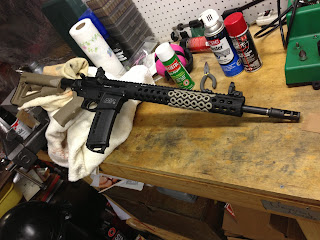Fulton Armory* M1 Carbine Review
Introduction
The M1 Garand has become the most famous military battle rifle every made, but a lot of people forget the importance of its little brother, the M1 Carbine. Interestingly enough, the M1 Garand and M1 Carbine only shared one common feature, they both used a rotating bolt design, but otherwise the operating systems were completely different. The M1 Carbine was introduced during World War 2 as a supplement to the trusty M1911 .45 sidearm for use by paratroopers and specialized military factions. Almost a dozen different contractors built the M1 Carbine for war use and at least one manufacturer still makes them today, making the M1 Carbine the most manufactured firearm of World War 2.
...A History
In the late 1930’s, after the M1 Garand had reached its final stages of design and adoption, the Army Ordnance received reports from random branches of special operations that the M1 Garand was too heavy and unwieldy for their needs. Shortly there after, a program was started (and not officially supported until 1941) to create a lighter infantry rifle that was more powerful than the standard sidearms of the time (M1911 and M1917 revolver) but more maneuverable than the cumbersome M1 Garand and/or the heavy Thompson Submachine Gun. Army Ordnance had already developed a new cartridge that all prototype rifles should be chambered in, that cartridge was the
.30 Carbine. This new, smaller cartridge still used the same 7.62mm diameter bullet but only had a bullet weight of 110 grains as opposed to the .30-06’s 152 grains. As well, out of an 18 inch barrel, the cartridge topped out at 1,990 feet per second while the massive .30-06 cartridge left a 24 inch barrel at a devastating 2,700 feet per second.
Winchester had been working on a new rifle for the military, but it was a larger rifle similar to the M1 Garand. It was designed by John Moses Browining’s brother, Jonathan “Ed” Browning, using the .30-06 cartridge and a new operating system dubbed the “M2 Winchester Military Rifle”. Unfortunately, Ed Browning died in May of 1939 and never complete the rifle. Later that year, at the request of some Army brass, Winchester hired David Williams, a former prison inmate that, once released, began perfecting firearm designs he started while incarcerated. One of his designs was a short stroke piston system which caught the eyes of Army officers whom recommended him to Winchester.
Winchester had high hopes that Williams could complete some of Brownings designs, including the M2 rifle. After a series of test by the Marine Corps, it was determined Brownings original design wasn’t reliable enough. Williams incorporated his short stroke piston and changed the bolt from a tilting design to a rotating design similar to the M1 Garand. By 1941, Williams had changed the rifles design to be much smaller and was able to shave off nearly five pounds. After a few more prototypes and tests, the M1 Carbine was officially adopted on October 22, 1941.
 |
| (c) Copyright Point-of-Aim Productions, 2013 |
Design
The M1 Carbine is a small rifle sporting an 18 inch barrel and weighs in at a mere 5.2 pounds. The unique feature of this rifle is its operating system. It uses a rotating bolt similar to the M1 Garand, but the way it works is completely different. The M1 Carbine uses a short stroke gas piston. When the bullet is fired, the gases become trapped in a chamber under the barrel that houses the piston, the force of the gas pushes the piston against the operating rod, which in this case is not connected to the piston. The force throws the operating rod back, cocking the hammer and rotating the bolt. The design proved incredibly effective.
The first models featured a flip rear sight that had two aperture settings and no bayonet lug. Prior to D-Day, an M1A1 version was created for paratroopers that included a folding stock for easier carry. Throughout the war, some rifles were arsenal reworked and silently dubbed the M1A2 which included an enhanced rear sight adjustable for windage and elevation and included a bayonet lug, these are what are most commonly seen today on the collectors market.
Shortly before the Korean War, the M1 Carbine was re-worked once again and included two huge changes. An entirely new trigger group and sear as well as a selector switch. Dubbed the ‘M2 Carbine’, these were able to be fired in both fully- or semi-automatic. A heavier, rounded bolt was added to decrease rate of fire and a new 30 round magazine was created. These saw action mostly in the Korean War and was contracted out to many other countries for their militaries. An incredibly rare M3 model was developed that added an infra-red scope. These saw very little action.
Customization
As with the Fulton Armory* M1 Garand Review, this review also has an asterisks (*) after ‘Fulton Armory’, and again, for the same reasons. The Carbine used in our tests started life as an arsenal refurbished rifle that had a Standard Products receiver with an Underwood barrel. It was originally refinished by James River Armory of Baltimore, MD whom did a great job on the wood and metal, but the barrel was completely shot-out and wasn’t accurate at all. Frustrated, I threw the rifle in my safe where it sat for a few years. I sent the rifle to Fulton Armory in December of 2012 for a complete rebuild. New sights, new operating rod, new extractor, metal refinishing, and most importantly, a new barrel. The barrel is a “match quality” Fulton Armory barrel that is guaranteed 3 MOA with Match ammo. None of this was cheap, however. Everything added up, I spent well over an extra $1200 for the upgrades. Add that to the $750 original price and that is one expensive M1 Carbine!
Performance
But was the extra $1200 investment worth it? ABSOLUTELY! One thing I do wish I had done was their National Match trigger job. It was introduced shortly after I picked my rifle up and as a self proclaimed trigger snob, I would have thoroughly enjoyed it. The new rifle was tested, as always, with a number of different types of ammo. We used Remington UMC, Prvi Partisan, Federal American Eagle, and DoubleTap. We also
tested a few hand loads out of the rifle, but more on that later. All of the ammo gave us good results out of the rifle. Nothing to write home about, but at the same time we didn't have any ‘Match’ ammo to work with. Hornady had recently introduced their Steel Match ammo, but we couldn’t get our hands on any. The best group we shot from the rifle at 100 yards came from the DoubleTap which was a little over 4 inches.
The fun came when we started testing our hand loads. We had two sets and both used a Hornady 110 grain FMJ. The first set used Alliant 2400 powder which is usually a magnum pistol powder but was said to be very good with the .30 Carbine. It shot about the same as the other rounds so nothing too spectacular from the lightest charge to the highest charge. We shifted to Hodgdon H110 which is also a magnum pistol powder and one that I use with great success in my .357 Magnum (See the Ruger GP100 Review). We were able to shoot a 2.5 inch group at 100 yards on two occasions. Most fell in the 3-3.5 inch group sizes. We were very happy until we saw over pressure signs in the cases. Luckily the most accurate shots came from lighter charges than those.
We had zero malfunctions from the purchased ammo but we did have issues with our hand loads. We figured out it was a sizing and seating issue with too heavy of a crimp. A few more batches with the fixes and we have had zero issues after 300 rounds.
 |
| (c) Copyright Point-of-Aim Productions, 2013 |
Final Thoughts
M1 Carbine’s these days are pretty plentiful on the used market, ranging in price from $400 for old beaters to over $2000 for early models with matching parts. Auto-Ordnance still makes new M1’s for around $800 and the reviews I have heard are good but I have never shot one myself. Fulton Armory M1 Carbine’s start at around $1500, but they are customizable. You can get them with different sights, trigger mods, and they now offer a paratrooper stock option. The M1 Carbine has always been a favorite rifle of mine just because its fun and easy to shoot. Got a chance to pick up a nice M1 Carbine? Do it.











